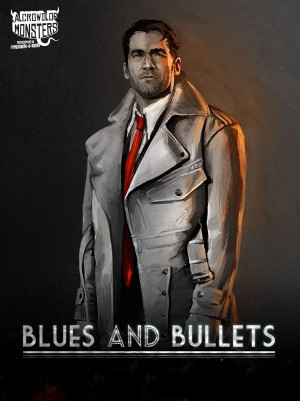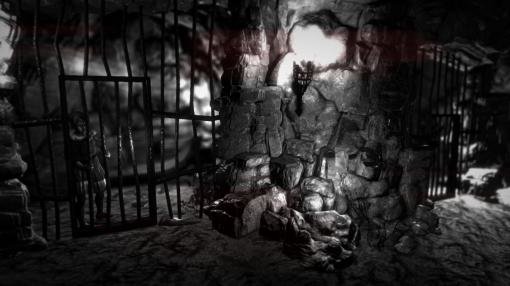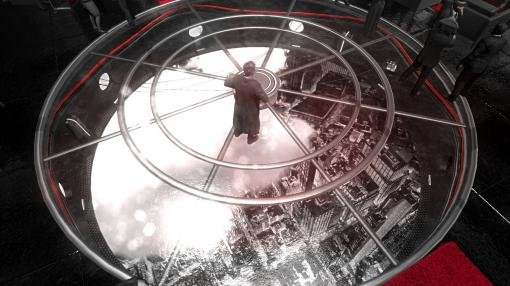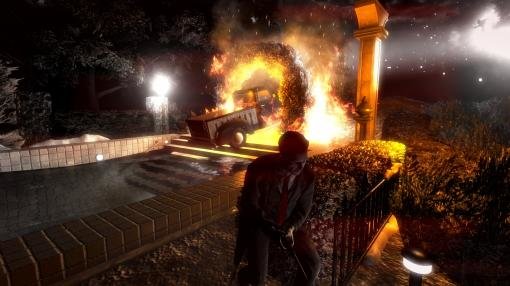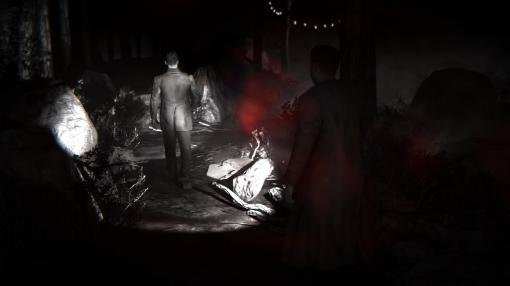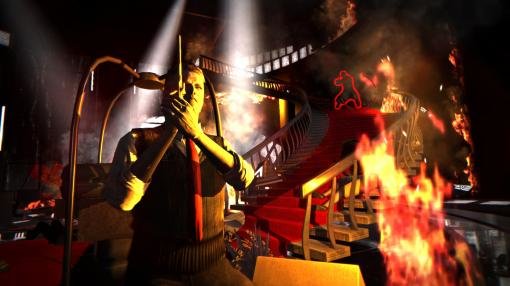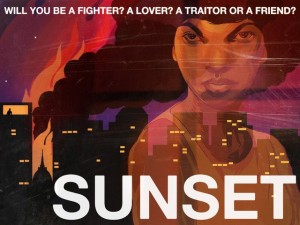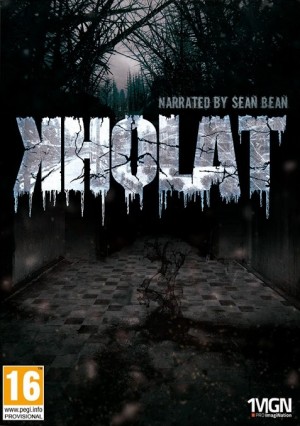Review for Blues and Bullets
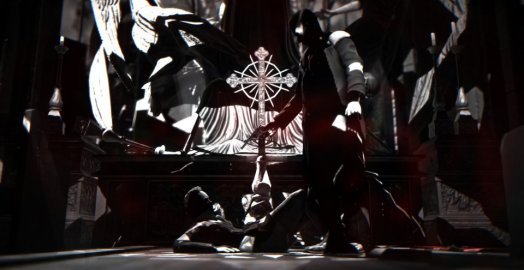
Take me straight to Episode 2!
Episode 1: The End of Peace
The first episode of Blues and Bullets: The End of Peace is an impressively stylish release from Spanish studio A Crowd of Monsters that appears ready to compete for the throne of current choice-based adventures. It boasts incredibly high-quality production, an outstanding flare for the dramatic, and an almost total lack of challenge or difficulty. It is breathtaking to look at, extremely well-voiced… and in some ways is barely even a game. What it does bring are two types of interactive experiences that I love: the ability to play as an actual historical figure in a different era, and the ability to play as an old-fashioned good guy.
That good guy is Eliot Ness, the real life Chicago police officer (technically classified as an Agent in the Bureau of Prohibition) who led the group of nine agents branded the Untouchables—so named by the media for their supposed inability to be turned by bribes or threats. Their work led to bringing down Al Capone, one of the most legendary gangsters in American history, all before Ness reached his thirtieth birthday. In real life, Ness had what is best described as a checkered career after the end of Prohibition and the fall of Capone, and he died relatively young at age 54, by that time so historically anonymous that no Chicago newspapers reported on his death. It was only through books, television, and the classic 1987 movie The Untouchables that Eliot Ness became an actual legendary figure.
That wouldn’t make much of an adventure game, so Blues and Bullets instead takes the real-life Ness and moves him into his retirement years in the fictional metropolis of Santa Esperanza. Here, Ness is enjoying a peaceful life as owner and proprietor of a small diner, making small talk with his regulars and talking tough occasionally to troublemakers—and apparently trying to think about his earlier violent run-ins with Al Capone and his gang as little as possible. Until one day, when a messenger brings Ness a reminder of the past he can’t escape from, and Ness quickly finds himself plunged back into a very dark, very disturbing criminal underworld.
You’ll see just how disturbing the evil portrayed is very quickly: the plot centers around what appears to be a child abduction ring; a frightening enough concept, but the game’s prologue puts you in the character of one of the abducted children, wandering around your cell, reacting to your captors and an upset fellow prisoner, and ultimately making a choice that could have very serious negative consequences. It is an absolutely terrifying sequence to play as a kidnapped child, exploring a horrific dungeon while other children plead for you to not endanger their lives. Despite the script being written by Josué Monchan, best known for his work on the Runaway series with Pendulo, there are virtually no light or comic touches to be found; this game is one hundred percent deadly serious and gets the heart racing even before Mr. Ness is introduced.
Although Eliot Ness and Al Capone are as real as the city of Chicago, the city of Santa Esperanza and Ness as the proprietor of an American diner are entirely fictional creations, and the intriguing alternate-history angle is taken to even further extremes—in this world, apparently the Hindenburg itself never exploded; rather, it’s been preserved and turned into a rather impressive floating luxury hotel where the elites of society tend to congregate, and where certain recently-freed crime kingpins are running the vestiges of their empire from. Granted, I never actually spent any time inside the infamous real-world dirigible, but I find it very difficult to believe that it could possibly have been large enough to house such an expansive social gathering, let alone an entire Japanese garden. Even more suspension of disbelief is necessary to accept the cable car in place to carry all these patrons to and from the sky, but the awe-inspiring aerial view of Santa Esperanza is worth every moment. Those who crave historical accuracy will be driven nuts by these liberties, but the game is nothing if not brave about its setting.
A vital element in maintaining the illusion of a real world in surreal circumstances is the voice acting, and thankfully the professional acting of this game is a great strength. The voice of Eliot Ness is Doug Cockle, whose name might be familiar as the actor behind Geralt, the titular Witcher from the popular RPG series. He is fantastically well-cast, with just the right amount of grit and anxiety for an emotionally-tormented retired detective deeply invested in a very troubling mystery. Across the board, the supporting characters are equally well-voiced; of particular note are the rather insane villains who show up in two different scenes, one of which is the incredibly gruesome, troubling ending sequence that I can’t encourage you enough to make sure you don’t play with children around. (In fact, you might not want to play it if you have young children, period). Never a distraction, the voice acting is a positive in every scene, which is a doubly impressive feat for a debut adventure from a rather small studio.
Blues and Bullets recommends a gamepad for playing, with an interface that will be very familiar to any fan of recent Telltale story games. It is possible to play with a keyboard, but using an analog stick to control Ness’s walking movements feels much more natural. There is only one button used for interaction, and automatic highlights make it very obvious where the infrequent hotspots are in any given scene. The dialogue sequences feature some familiar moments of choice, which wisely involve selecting general emotional tones rather than picking from specific lines. These decisions have a clear impact on the flow of that specific conversation, but rarely did I encounter any choices that appeared might really change the overall story (though to be fair, I only played through the episode once).
Sometimes the only choice I felt like I was making was how long to walk around and enjoy the visuals—a surprising outcome for me, since I was immediately skeptical upon seeing that the game borrows the black, white, and blood-red aesthetic of Frank Miller’s Sin City. Although a minimalistic neo-noir color motif like that can be stylish if used correctly, in the wrong hands it creates a world that is bland, or even difficult to properly see. No such worries about Blues and Bullets, which is exceptionally drawn and animated throughout. There is always so much happening in the surrounding world, especially the amazing scenes inside the Hindenburg hotel: a truly living environment full of people talking to each other, walking around, and creating an incredible sense of reality. Water and rain effects are amazingly lifelike, and the natural animations of arms and legs moving are impressive throughout. The camera also moves with a great eye for drama; the final scenes at an eerie dock are preceded by a gorgeous, lengthy camera pan of the entire area.
The game uses its visual prowess to great use, if you’re a fan of grotesque and scary horror. Standing out from the black and white backdrops, the game drips with dark red blood, particularly during two scenes. One of them is the game’s lengthy “action” scene, a cover-shooting diversion that flashes back to the first Ness-Capone confrontation (which I’m sure was significantly less casualty-ridden in real life) and is the game’s weakest scene; it’s nearly challenge-free and provides almost no legitimate chance of being killed, while you freely explode the heads of waves of henchmen in the goriest fashion. It’s a nice reminder that adventures trying to blend in other genres should stick to doing what they do well, but it ends quickly enough and is thankfully a one-off for this episode.
The other deeply unnerving scene is the game’s central set piece: an attempt to visit an informant at his house, only to find that he has been found first by someone with bloody intentions. Someone, or something, that has labored to commit murder in the most horrific, revolting, gory manner possible. Those with weak stomachs need not apply. The blood spatters throughout this scene are straight out of a 1980s Troma movie, but the game’s dialogue is so self-serious that the tone of the scene is truly disturbing—ultimately in a positive way for the suspense factor. This scene also features a brief action-y sequence in the vein of The Wolf Among Us: a series of quick button-presses per the onscreen button prompts to avoid attacks and properly counter-attack. The fight scene is easy enough, ends quickly, has no random elements, and restarts almost instantly with each death so it’s hard to really consider it the same kind of diversion as the ludicrous “Assault on Al Capone” scene.
Other than these harrowing scenes of violence, the game features one extended puzzle that is the only real moment of classic adventure-style intellectual challenge. While exploring the grisly murder scene, you examine the surroundings to accumulate clues, which pop into your mental “inventory” for you to then piece together to provide the answers to such questions as how the killer got in, where the body was moved from, etc. I would hesitate to call this much of a challenge, though, as all you really need is a good eye for detail as you’re walking around to avoid missing any clues. Actually figuring out which category to associate with each clue is no real difficulty at all, and once that’s done, Ness’s inner dialogue will answer all the burning questions without you having to reach an independent conclusion.
That’s really the only drawback of The End of Peace: it’s essentially just an interactive movie with one out-of-place action sequence. It involves walking around and finding hotspots, and there is quite a bit of dialogue and emotional choice, but none of it seems to have any potential lasting impact on the game’s storyline branching. Coming into the game looking for a challenge or a traditional adventure could leave you feeling a bit underserved. But if you approach Blues and Bullets looking for an incredibly stylized, bleak neo-noir murder mystery with some horror elements that takes some amusing liberties with history but still lets you play as a legit good guy, you’ll love every minute of the two-hour first episode and, like me, you’ll find yourself eager for the next episode.
Episode 2: Shaking the Hive
Spanish developer A Crowd of Monsters continues to turn the historical legend of Eliot Ness and legendary crime boss Al Capone upside down with their noir adventure series Blues and Bullets with a second episode even more stylish, beautiful, and wincingly gruesome than the outstanding first installment. The mystery is compelling and the art is beautiful, but unfortunately the game is even more action-bloated than its predecessor.
Shaking the Hive picks up where the first episode left off, with our hero Eliot Ness on a mission from Capone to find the gangster’s missing niece. The search has led to the docks of the fictional city of Santa Esperanza (the replacement for Chicago in this alternate history), where a disguised Ness is to meet up with a very bad Russian criminal named Ivankov, in hopes of uncovering the secrets behind the city’s growing epidemic of missing children.
The game does not rush into this confrontation, however, instead taking a brief detour at the beginning to play through a flashback sequence from twenty years earlier in Ness’s life—back to when he was the leader of the Untouchables, an honorable man refusing to compromise his morals in pursuit of the crime boss Al Capone, but still prone to decisions of questionable morality. This scene, primarily a lengthy conversation with his mistress of the time who was married to Ness’s friend and partner, is so well-written and the voice acting so uniformly excellent that I had no objection at all with this small digression from the cliffhanger ending last time. The scene also establishes that, as heroic a figure as Ness may be when opposing criminals, the things he does to further his affair at the expense of his close friend expose a very flawed man. It’s this complexity that makes Ness a truly compelling player-character.
Once the story returns to modern day, things get darker and more gruesome in a hurry. Disguised as an underworld criminal—complete with mask to hide your recovery from facial identity surgery—and accompanied by your sidekick Milton, who has been assigned to stay close to your side by Capone himself, you enter Ivankov’s submarine in no way prepared for the atrocities you’ll find. The situation deteriorates rapidly, and after some distracting gunplay (more on that later), you’ll find yourself exploring the depths of evil in the depths of the vessel, piecing together the horrific crimes committed by Ivankov. This investigation sequence follows the same blueprint as the previous episode: you walk through various rooms and look at hotspots to gather clues, which are represented as cards to be assigned to questions on the in-game investigation board. For example, was Ivankov running the type of criminal enterprise he’s initially suspected of? Three specific clues answer that question, and after collecting them, you select the appropriate clues to verify the answer.
After all clues are obtained and correctly associated with their respective questions, a very lengthy sequence plays out where all the pieces are assembled in a hyper-stylized manner to demonstrate what happened. The game then pauses on another minor cliffhanger to insert another flashback, this one back to a time before the earlier flashback, when Ness and his partner and friend Jim Dockers (whose wife Delphine has now been established as Ness’s lover) are on an investigation together as their conversation takes a very dark, and potentially dangerous, turn. At this point, you understand the choices Ness has made and the effect they’ve had on Dockers. There’s an external threat to deal with as well, and the scene carries consistent legitimate tension, amplified further by incredible shadowy visuals and some outstanding moments of dialogue choice.
The game eventually reunites Ness and Capone and, through an extremely violent final half-hour that sets the table for what appears to be a supernatural, monster-movie story element, puts them on a collision course with the ultimate evil for the third episode to come. Shaking the Hive’s epilogue is a continuation of the first episode’s final scene, and is as troubling and unnerving as its prior companion, reminding you that of all the bloody crimes you’ve witnessed and committed so far in two episodes, there is still nothing as heart-wrenching as the mistreatment of children.
Not only does the story of Blues and Bullets continue to be gruesome, dark, and incredibly compelling, the game pulls no punches visually: gory chainsaws, hacked-off limbs, bloody pawprints, and plenty of other details both shown and described should steer away the squeamish. The brutality is implicit while investigating and explicit during both the cover shooting and Quick Time Event fight scenes. The choice mechanics allow you to decide how much violence you’ll commit yourself, but ultimately do not drive any significant deviation in the path, and you are helpless to reduce the amount of overall bloodshed. However, your decisions do carry quite a bit more emotional heft than the mostly tacked-on choices from the first episode.
Framing this story is an array of fantastic technical elements. The visuals are jaw-dropping in nearly every scene; I found myself constantly taking notes of things that I found remarkable to look at. The game opens many of its scenes by featuring lengthy, sweeping establishing shots to give you a sense of the depth of the settings. From the water rippling at the seaside pier to the wind-whipping movement of outdoor foliage to a breathtaking climax high in the sky, even with a lack of color the environments are consistently beautiful to look at. It’s not just the black, white and occasionally red background details either; the animation is near-perfect too. A large strip door on the submarine moves realistically as your character walks through it, and the effect of holding a flashlight during a nighttime investigation is brilliantly tense. In one outside sequence in the rain, water drops splattering on the camera lens is incredibly cool. And so on; I never, ever got tired of looking at this game.
Along with the remarkable graphics is a great lounge-noir soundtrack, providing an unsettling but not overly intrusive musical backing, plus some of the best voice acting I’ve heard in a modern adventure. There’s no disputing the credentials of Doug Cockle as Eliot Ness, who shows his versatility by adding a great deal of upbeat youthfulness to Young Eliot during the flashbacks before returning to the grizzled, bleak veteran of present-day. But also of note in this episode are Tom Clarke-Hill, a white baritone voice actor who perfectly portrays Ness’s black bodyguard Milton, an exceptional supporting character who steals every scene he’s in; and John Guerrasio, a professional stage actor who is fantastic as Al Capone. Nearly everything about this game screams quality AAA design, but the voice acting in particular is head and shoulders above nearly anything this genre has offered in many years.
While Shaking the Hive focuses primarily on story advancement, it manages to avoid actively insulting your intelligence. Hotspots are highlighted as you walk toward them during the one lengthy investigation sequence, but there is still some actual observation and processing of information necessary, although you can brute force your way through the evidence board with guesswork, as there is no real way to fail or any obvious penalty for wrong answers. There aren’t any inventory puzzles, but there’s a safe combination that does require you (without overt assistance from the game) to do some analysis of the clues that you’ve discovered. I feel like this type of investigation is where the game shines and I wish there was more than one such sequence present in this episode.
Unfortunately, what you get two of is Blues and Bullets’ least interesting offering: ludicrous, drawn-out cover shooting sequences. They are not hard; in fact, the absolute utter lack of challenge is one of the real negatives of these scenes. But they are interminable, with wave after wave of criminals—often three or four at a time—who are barely able to graze you when you pop out from cover to rain down showers of blood on them. You’d need to stand foolishly exposed for a very long time before the enemy got enough shots to actually kill you—which even then only instantly rewinds you to the beginning of the current wave. My ire was already up after the first such shootout, but when the episode goes back to the well for another endless firefight, I couldn’t wait for it to be over. The only saving grace of the second sequence is that it does allow you to mow down a few bad guys while playing as Al Capone himself, which was enough to put a smile on my face for at least a couple waves.
Another negative to be mentioned is the fixed camera. The game is rendered in 3D, but the only way to move the camera is to walk along the right pre-set path and trigger a camera movement. Like many such fixed cameras, the game gets way too close as you’re trying to walk toward it and you’ll often find yourself banging into items you can’t see, fumbling around until you find precisely the right path. I understand that a full sweeping camera is difficult to implement, but a zoom feature surely would have solved some of the frustration present in the scene where it’s really an issue.
These are not big complaints, however, and they did not materially subtract from my enjoyment. I am gushing about this game because it is so interesting narratively, incredibly strong on nearly all technical fronts, and ultimately succeeds by injecting infinite amounts of style into everything. You see it in the visuals, you hear it in the music, and you feel it in the violence of the story and the sharply contrasted flashback scenes to quieter, but equally emotional, times in our hero’s life. Blues and Bullets takes many common modern adventure mechanics and noir tropes and assembles them into its own unique style in a game that I never wanted to stop playing. At a length of about two and a half hours with really no difficulty to speak of, the second episode is thoroughly immersive and will leave you immediately thinking about where things will go from here.
I have a pretty strong personal rule about not playing through choice-based games multiple times, but for the second episode in a row, Blues and Bullets is testing my resolve because there are numerous moments that I truly want to experience again. Many of them involve just walking around and taking in the scenery; others include the wonderful interactions between Ness and Milton and a couple of the awesome set-piece fighting sequences. However, my desire to play through those moments is significantly tempered by my severe lack of interest in ever playing through the ridiculous cover shooting sequences again. As much as I sincerely can’t wait for the third episode, I will hold out hope that the design direction will be a lot more blues, and a lot less bullets.




